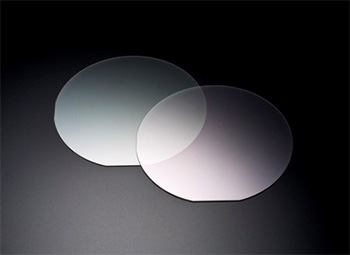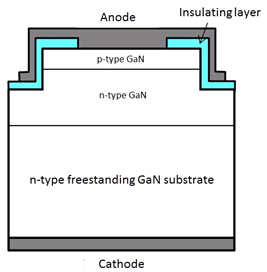2012 The former Hitachi Cable News Release
Information (including product prices, product specifications, details of services, launch dates, inquiry information, and URLs) contained in this news release is current as of the date of the press release but is subject to change without notice. Please note that details may differ from those effective on the search date.
Succeeded in the trial manufacture of the world's first gallium nitride
vertical diode that can withstand 3,000V
Hitachi Cable is announcing that we have succeeded in the trial manufacture of the world's first*1 gallium nitride (GaN) vertical diode with a high reverse breakdown voltage of 3,000V or higher and a low on-resistance of about 1mΩcm2 in the forward direction. We achieved this development through joint research with Toru Nakamura Laboratory in the Research Center for Micro-Nano Technology of Hosei University (hereinafter "Hosei University") and the Central Research Laboratory of Hitachi (hereinafter "Hitachi").
In recent years, public interest in power devices as a way to conserve energy has been increasing. Power devices are semiconductors such as diodes and transistors with the ability to convert and control electricity. They are used in a wide variety of fields, including consumer electronics in houses, automobiles, railroad vehicles, and power plants. Conventional power devices have mainly used silicon (hereinafter "Si"). To further reduce energy consumption, however, there has been active development of power devices using new materials which exceed the performance limits of Si.
Under such circumstances, Hitachi Cable succeeded in the trial manufacture of the world's first GaN vertical diode with a high reverse breakdown voltage of 3,000V or higher and a low on-resistance of about 1mΩcm2 in the forward direction through joint research with Hosei University and Hitachi.
This is a GaN vertical p-n diode with an electrode diameter of 400 to 800µm in which GaN epitaxial layers are embedded upon Hitachi Cable's freestanding GaN substrate using the MOVPE (metal organic vapor phase epitaxy) method.
The freestanding GaN substrate used in the sample diode made possible a stable, low-defect density of dislocation of 106cm-2 thanks to the VAS (void-assisted separation) method developed by Hitachi Cable. We have also confirmed that the dislocation defects in the freestanding GaN substrate are only observed in edge dislocations and mixed dislocations, and also that nowhere on the entire surface of the substrate is there a "core" area where dislocation defects are densely located. The voltage resistant test using sample diodes confirmed a high reverse breakdown voltage of 3,000V or higher, demonstrating that the dislocation defect in our freestanding GaN substrate is not a killer defect which significantly degrades the performances of power devices. This test also demonstrated that the epitaxial layers grown on our freestanding GaN substrate have a breakdown field which is close to the ideal GaN value (3.3 - 3.8MV/cm).
The test also indicated that the on-resistance of this diode in the forward direction is about 1mΩcm2, smaller than the sum of the resistances at each layer of the diode, meaning that conductivity modulation which lowers the resistance occurs when an electric current is injected. Conductivity modulation is an excellent effect which can increase the performance of a device beyond its material's inherent performance limits. While it is often used in Si power devices, it has rarely been seen in compound semiconductors, which have short carrier life*2. In terms of this diode, Hitachi's theoretical analyses have suggested that the light generated at a p-n junction is re-absorbed by a diode, and that conductivity modulation, which increases carriers, occurs due to the absorption. This time, Hosei University experimentally demonstrated the light-emitting properties of diodes.
These findings demonstrated that the freestanding GaN substrate produced by the VAS method is capable of making possible power devices with a much higher performance index than with conventional materials such as Si and silicon carbide (SiC). High-efficiency power devices based on this development are expected to reduce the power consumed by equipment and facilities in the future.
Hitachi Cable is committed to working on the sales of freestanding GaN substrates to be used in optical devices as well as to the expansion of our compound semiconductor business by putting more effort into expanding the sales of freestanding GaN substrates for power devices and GaN epitaxial wafers grown using the MOVPE method.
Hosei University is planning to present these research findings at the 73rdJSAP (The Japan Society of Applied Physics) Autumn Meeting 2012 , held in the Johoku area of Ehime University and the Bunkyo Campus of Matsuyama University from Tuesday, September 11 to Friday, September 14 (lecture numbers: 12p-F2-15 and 12p-F2-16).
Appearance of GaN substrates for power devices
A schematic cross-section of a sample diode created in this study
| *1 | It was the first case in the world to successfully achieve a reverse resistance of 3,000V or higher and an on-resistance of about 1 mΩcm2 in the forward direction in a power device in which GaN epitaxial crystals are grown on an freestanding GaN substrate (As of July 4, 2012, researched by Hitachi Cable). |
| *2 | "Carrier" means a particle which carries electrical charge. Electrons and electron holes carry electrical charges in p-n diodes. |

